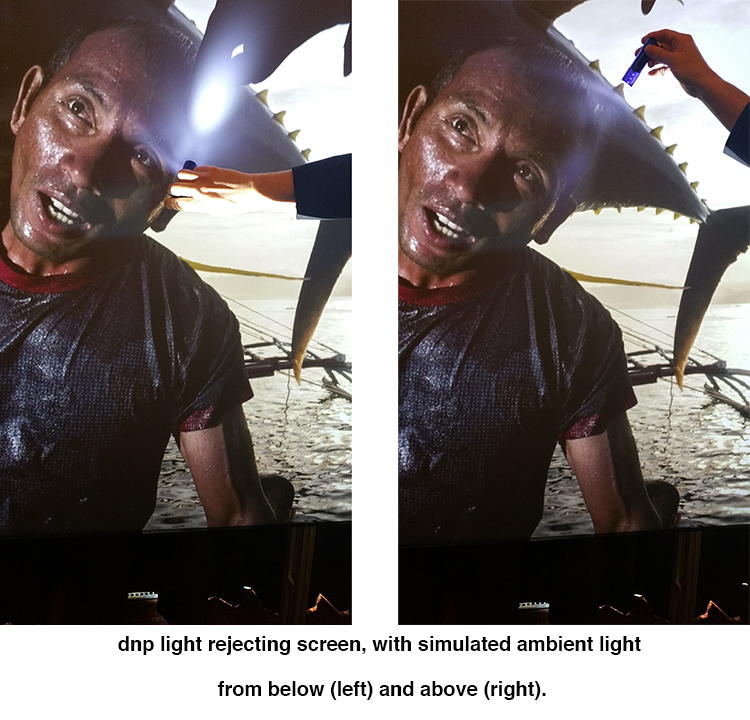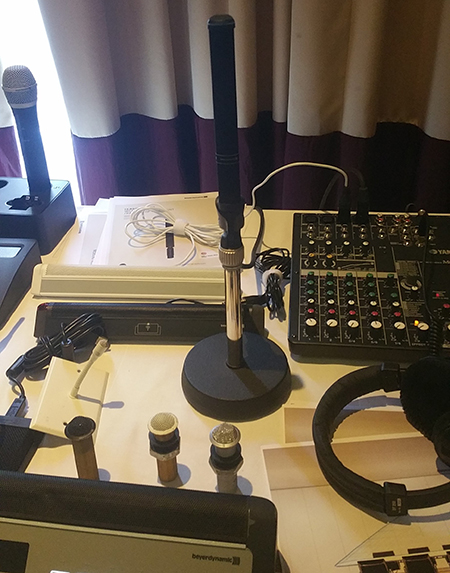A Visit with SYMCO
AV Distributor SYMCO rolled into town today for its annual roadshow. Various other commitments kept me from the various days’ events — including an end-users’ roundtable featuring not only one of our clients from SMW, but also one with whom I’d worked personally. However, I did have the opportunity for a quick stop to chat with the various manufacturers and reflect. Who did I see and what thoughts did they bring to me? Read on!
There were no less than two screen manufacturers present: Italian Screenline and California’s own DNP. Screenline has a fairly standard and familiar line of products: electric motorized screens (tab-tensioned and not), fixed screens, acoustically transparent material, etc. The company’s live demo was of a fixed screen that functions as a whiteboard. It was pretty nice optically, handling a short-throw projector with minimal hot-spotting. It was a nice demo, but Screenline is moving into a somewhat occupied space in the market. I wish them luck.
 Also present were the good folks at DNP with a short throw projector and a nifty light-rejecting screen. They actually sell a projector plus screen as a single unit for less than $7,000. The single skew for both, the low cost, and the size of the image serve as a reminder that there’s still a space for projection; a similarly sized flat panel display would be cost-prohibitive for many projects. What’s interesting about this combination is that putting a short-throw projector beneath the screen allows it to be placed so that it rejects light from above. DNP’s Randy Pagnan gave a nice quick demo with a flashlight. I’ve seen this once before, but it never fails to impress me. It’s a great solution for retrofits in spaces without properly zoned lighting.
Also present were the good folks at DNP with a short throw projector and a nifty light-rejecting screen. They actually sell a projector plus screen as a single unit for less than $7,000. The single skew for both, the low cost, and the size of the image serve as a reminder that there’s still a space for projection; a similarly sized flat panel display would be cost-prohibitive for many projects. What’s interesting about this combination is that putting a short-throw projector beneath the screen allows it to be placed so that it rejects light from above. DNP’s Randy Pagnan gave a nice quick demo with a flashlight. I’ve seen this once before, but it never fails to impress me. It’s a great solution for retrofits in spaces without properly zoned lighting. I also saw my old friends at Beyerdynamic. I’m going to pause to talk to all of the manufacturers out there reading this. I know that you’re proud of your product, and I appreciate that you believe in live demos. You’re right, to an extent: A live demonstration is the difference between an in-person meeting and just a spec sheet on the Internet. All that said, please do yourself a favor and check the demo yourself before sharing it. The microphone in question — the Classis RM30, built with five internal capsules — is a nice piece of hardware. The problem with the demo is that it’s almost TOO good; in a crowded room, it picked up mostly crowd and background noise, leaving the actual audio from the talker fairly muddled. It looks like a nice product, but the demo reminded me of Biamp’s demo of its ceiling microphone a couple InfoComms ago. I’d like to get my hands on the product to test it under better circumstances. On the positive side, Beyerdynamic had some nice application suggestions, including ceiling-mounting it to cover a conference table from above. This could be a nice midpoint between simple pendant microphones and more costly digitally-steered mic arrays. If I get my hands on one, I promise to tell you all about it.
I also saw my old friends at Beyerdynamic. I’m going to pause to talk to all of the manufacturers out there reading this. I know that you’re proud of your product, and I appreciate that you believe in live demos. You’re right, to an extent: A live demonstration is the difference between an in-person meeting and just a spec sheet on the Internet. All that said, please do yourself a favor and check the demo yourself before sharing it. The microphone in question — the Classis RM30, built with five internal capsules — is a nice piece of hardware. The problem with the demo is that it’s almost TOO good; in a crowded room, it picked up mostly crowd and background noise, leaving the actual audio from the talker fairly muddled. It looks like a nice product, but the demo reminded me of Biamp’s demo of its ceiling microphone a couple InfoComms ago. I’d like to get my hands on the product to test it under better circumstances. On the positive side, Beyerdynamic had some nice application suggestions, including ceiling-mounting it to cover a conference table from above. This could be a nice midpoint between simple pendant microphones and more costly digitally-steered mic arrays. If I get my hands on one, I promise to tell you all about it.Perhaps the most interesting vendor there was Utelogy, a company offering a cloud-based AV control/asset management/monitoring platform which, so far as I was able to learn, runs on a .net framework. It’s deployable either via Utelogy’s cloud service or (for a higher licensing fee) hosted locally. This would be AV control with no boxes — everything runs on a server (or a virtual server) and sends and receives IP strings. It’s no accident that Utelogy shared a display table with Global Cahe, makers of IP to RS232, IR and relay devices. It’s very easy to see how, with very little hardware, one could build an otherwise completely virtualized control system. The company’s strength is in marketing to IT managers — the IT world understands and is comfortable licensing services. As we centralize more and more and as traditional AV equipment vanishes, this is a very interesting direction. In addition, tightly integrated applications including soft Codecs and recording platforms. The integration was tighter than I’d seen with traditional AV manufacturers and is certainly the wave of the future.
Uteology’s problem in the AV world is that, as of now, it doesn’t have nearly the support of the traditional AV control manufacturers. I asked about some local AV programming houses, and was told that at least one of them had shown — at this time — very little interest. Absent an ecosystem of programming resources, this will be very hard to implement through traditional AV channels. Where I could imagine seeing it is in smaller projects handled more by IT-centric teams rather than traditional AV installers. Eventually I expect either the traditional manufacturers to catch up, firms like Utelogy to build up a group of capable programming resources, or a combination of the above. As always, we shall see.
I also had a quick visit with Marshall Electronics, which really wants to be seen more in the commercial AV space rather than continue to be perceived as only a broadcast manufacturer. The most interesting things from Marshall were some simple, reasonable-cost tools: an H.264 encoder/decoder and an HDMI-USB converter. The latter is interesting for two reasons. First, it’s far lower-cost than things like the Vaddio AV Bridge or Extron MediaPort. It does lack quite a bit of the capabilities of those products, having only an HDMI input and a USB3.0 output. There have been many times, however, when I’ve specified an AV bridge to use solely as an HDMI converter. It’s nice to see one without the audio embedding, scaling, streaming and other functions at a reduced cost for those times when one doesn’t need more. In addition, it’s interesting to see USB 3.0. Long-term, I’m not sure that this won’t be a dead-end connector and lose out to USB-Type C, but it’s still a differentiator. Marshall also showed off cameras, both small form-factor and pan/tilt/zoom, as well as its familiar rack-mount LCD preview monitors.
SVSI is still with Symco and claims that it will be for a time, but I find that a bit hard to believe given the purchase by Harman/AMX. As you know, it took a very short time for SVSI to be branded as AMX and get AMX-style part numbers. Don’t be surprised to soon see the “card-type” SVSI encoders and decoders be re-skinned to fit into Enova DGX chasis. This will catch AMX up to Crestron, which has featured H.264 streaming cards in its DigitalMedia products for some years now. In fact, that’s been a major advantage for Crestron in a more network-centric world, allowing easy and seamless integration of streaming for applications such as desktop mirroring, transmission to distant overflow spaces and integration with software-based recording applications. It will be nice to see more players joining them in that space.
There wasn’t much else that very much caught my eye. FSR and Broadata were both showing HDBaseT products, which are quite familiar to us by now. Broadata’s wrinkle was on-board control processors, allowing very simple room systems to hook into building management software without additional control hardware. FSR had the very smallest HDBaseT transmitter and receiver units I’ve ever seen, at about a half-inch thick. There’s not much to say about HDBaseT that I’ve not said before. It’s interesting to see new details and features, but that’s about all that there has been for some time now. We’ll see when the next big step comes.
That’s all for now. Stay tuned, perhaps, for a more in-depth look at the Beyerdynamic RM30 once I get my hands on it.





